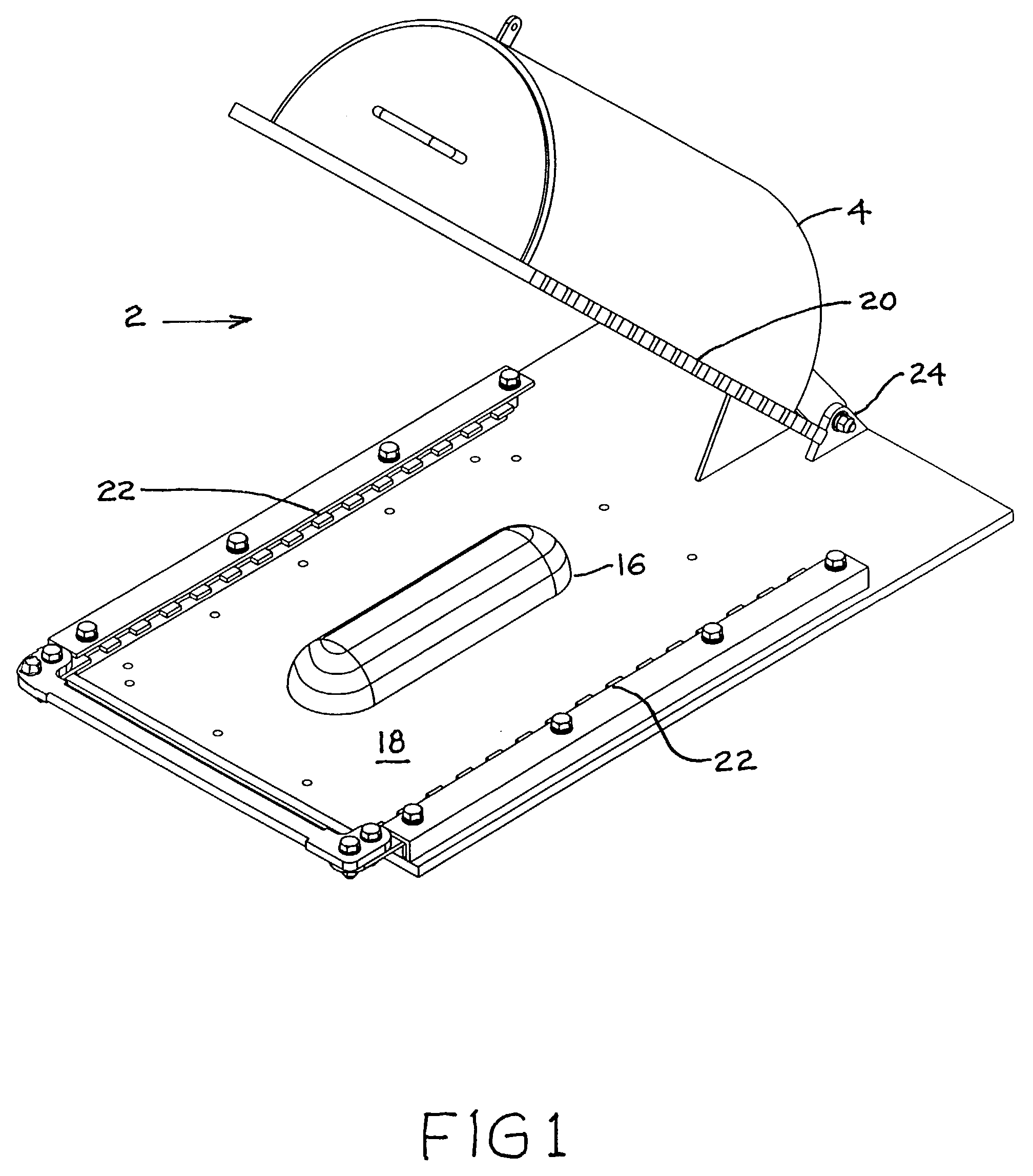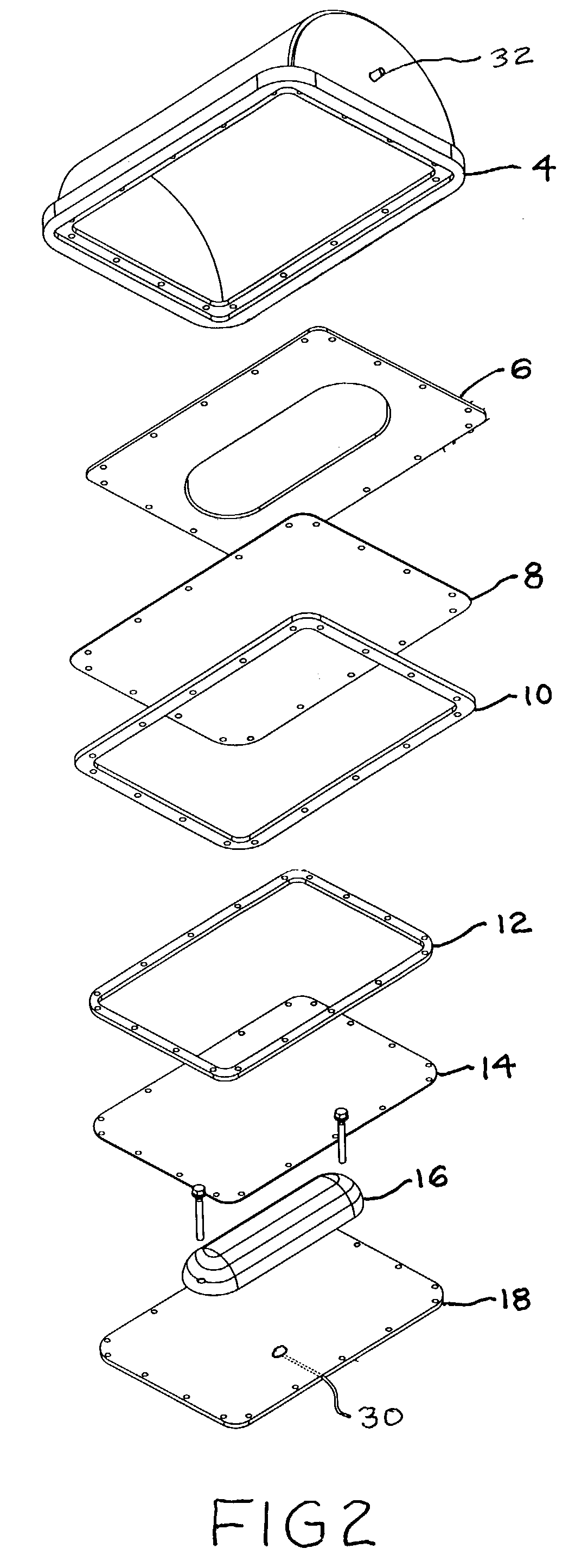Rapid thermoform pressure forming process and apparatus
a thermoform and pressure forming technology, applied in the field of thermoform pressure forming process and apparatus, can solve the problems of high cost of materials, tooling and equipment required to make parts using pre-impregnated materials, voids between thermoform material and mold, and voids in the mold, etc., to achieve rapid heating, molding and cooling of molded parts, and superior strength and accuracy of placemen
- Summary
- Abstract
- Description
- Claims
- Application Information
AI Technical Summary
Benefits of technology
Problems solved by technology
Method used
Image
Examples
second embodiment
[0097]FIG. 14 is an exploded isometric view of the invention comprising a double pressure chamber with triple bladder. Specifically, FIG. 14 illustrates clockwise from the bottom left flexible air pressure manifold lines 38, with control valves 39, lower pressure chamber 40, chamber connector hinge 45, hinge axis pins 47, lower bladder 42, lower flange plate 44, with an inlet / outlet 46, convex mold 48, second lower bladder 50, second lower bladder retaining frame 52, upper retaining frame 54, upper bladder 56, upper flange 58, and upper air pressure chamber 60. Chamber 40 has a connecting air inlet / outlet connector 41 which connects with the manifold 38. Likewise, chamber 60 has an inlet / outlet connector 62 which connects with manifold 38.
[0098]FIGS. 15 to 20 show a sequence of steps for molding a thermoformable composite or thermoplastic material on a positive (convex) mold surface. FIG. 15 illustrates an end view of the double pressure chamber and triple bladder second embodiment ...
third embodiment
[0109]FIG. 26 illustrates an end section view of the dual air pressure chamber, triple bladder third embodiment with the upper air pressure chamber 60 pivoted away from the lower air pressure chamber 40, with the negative molded thermoformable fibre reinforced material 64 lifted up off the second lower bladder 50 above the mold, including flash 72 and trim line 71 around the thermoformed part 64. The part is now ready for trimming. A concave molded thermoformable fibre reinforced composite material 64 is formed.
fourth embodiment
[0110]FIG. 27 illustrates an exploded end section view of the invention wherein an embedded fastener attachment 76 is accurately located between two or more layers of thermoformable fibre reinforced composite material 78, 80 over a mold 82. A jig (not shown) or some other location device can be used to position the attachment accurately on the mold prior to heating and pressurizing the thermo-composite material.
[0111]FIG. 28 illustrates an end section view of the fourth embodiment of the invention wherein the embedded fastener attachment 76 is encased between the two layers of thermoformable fibre reinforced composite material 78, 80 over the mold 82. The two layers 78, 80 are heated and then compressed together utilizing any of the three thermoforming methods illustrated in FIGS. 1 to 26. A bolt 84 is installed, using the rapid molding process as illustrated in previous drawings and according to the description. Embedded fasteners can be post machined to receive standard sized bolt...
PUM
| Property | Measurement | Unit |
|---|---|---|
| temperature | aaaaa | aaaaa |
| time | aaaaa | aaaaa |
| air pressure | aaaaa | aaaaa |
Abstract
Description
Claims
Application Information
 Login to View More
Login to View More - R&D
- Intellectual Property
- Life Sciences
- Materials
- Tech Scout
- Unparalleled Data Quality
- Higher Quality Content
- 60% Fewer Hallucinations
Browse by: Latest US Patents, China's latest patents, Technical Efficacy Thesaurus, Application Domain, Technology Topic, Popular Technical Reports.
© 2025 PatSnap. All rights reserved.Legal|Privacy policy|Modern Slavery Act Transparency Statement|Sitemap|About US| Contact US: help@patsnap.com



